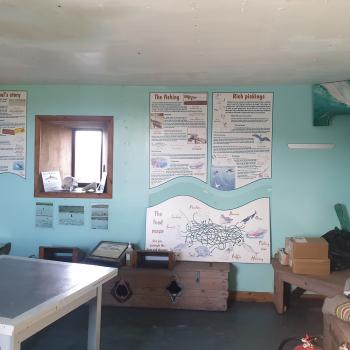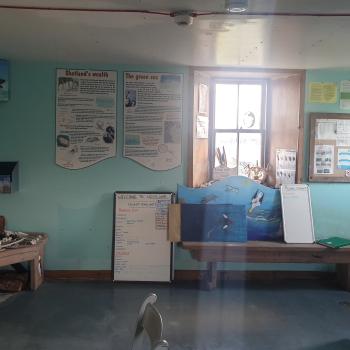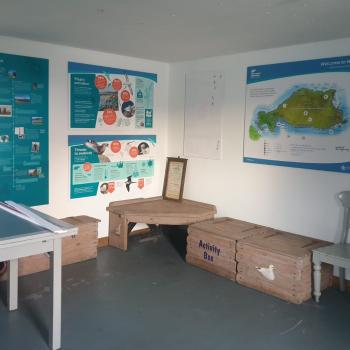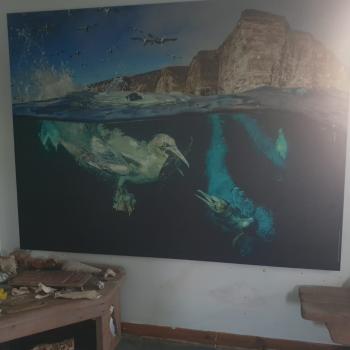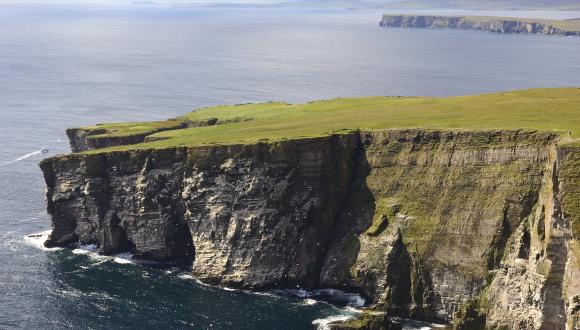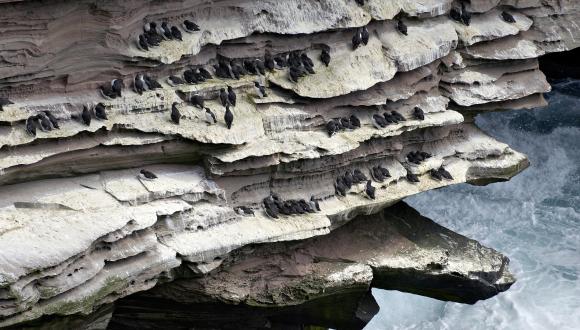The Reserve Plan Review for Noss National Nature Reserve 2014 - 2024
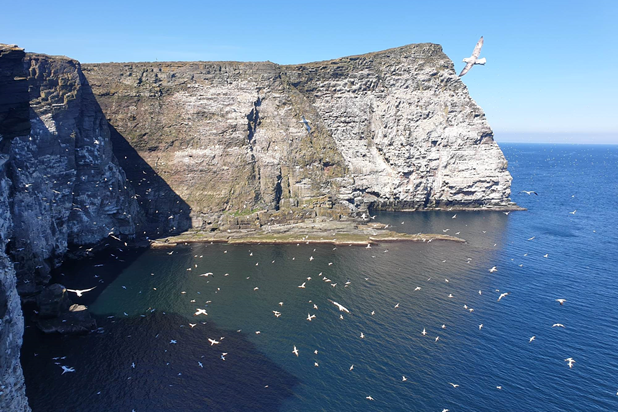
Foreword
Noss NNR is one of a suite of NNRs in Scotland. NNRs are special places where some of the best examples of Scotland’s wildlife are cared for. Nature comes first on NNRs, and people are welcome to discover the rich natural heritage of these places and to contribute to our knowledge and enjoyment of these areas.
In 2014, we carried out a public consultation on our future proposals for the management of Noss NNR. Your feedback from the consultation informed the completion of the Reserve Plan 2014 – 2024, which set out our management for the reserve during that period. We have now come to the end of that plan and have started to think about the future direction of our management. This report reviews our achievements and progress against the management objectives set out in the Reserve Plan for Noss NNR 2014 - 2024.
Address:
NatureScot
Lower Ground Floor
Stewart Building
Alexandra Wharf
Lerwick
Shetland
ZE1 0LL
Email: [email protected]
Our Vision for Noss NNR
Noss National Nature Reserve is special; the aim is to keep it that way. The Reserve Plan 2014- 2024 sets out our vision for the Reserve describing how we would like the Reserve to be in 2038. The management we have carried out over the past 10 years has been framed with this vision in mind.
Vision
- Noss is renowned as a classic seabird island and it retains a natural and wild feel
- Noss is a quality visitor experience – there are more visitors to Noss and the island is an exemplar of sustainable tourism
- Noss is high profile – more people are aware of the island and its wildlife
- Noss meets the needs of wildlife, visitors and other land managers
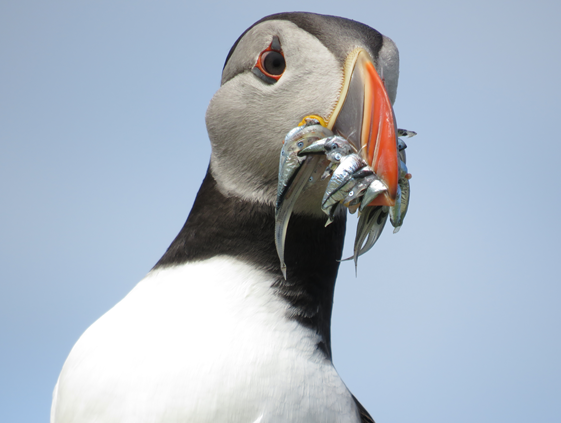
Management for Natural Heritage
Objective NH1: Ensure the reserve continues to provide appropriate nesting habitat for the range and populations of breeding seabirds; continuing our commitment to their long-term monitoring and using this to inform our understanding of the impacts of climate change and marine development/activities on seabirds.
Projects to be delivered during life of plan
| Task No. | Task description | Task outcome |
|---|---|---|
|
NH1.1 |
Graze sheep at 1 per ha. to maintain suitable sward for nesting great skua and Arctic skua. |
Achieved and ongoing |
|
NH1.2 |
Provide instruction to visitors to prevent accidental disturbance of nest sites on moorland and at cliff ledges. Manage visitor access to sensitive areas. |
Achieved |
|
NH1.3 |
Continue annual programme of long-term seabird productivity monitoring, population surveys and 6 year programme of 'all island' counts, providing results to JNCC seabird monitoring programme, Shetland Bird Club (for annual reports). Annual counts contribute to Site Condition Monitoring (SCM). |
Achieved |
|
NH1.4 |
Use long-term monitoring data to contribute to studies which increase our understanding of the impacts of climate change and marine developments and activities on seabird populations. Disseminate on Scotland's Environmental web. |
Achieved |
|
NH1.5 |
Undertake SCM for fulmar, gannet, great skua, guillemot, kittiwake, puffin, Arctic skua and the seabird colony/assemblage in 2014/15 onwards. |
Achieved |
|
NH1.6 |
Provide opportunities and logistic support for research projects especially where these relate to climate change and foraging ranges/behaviour of seabirds at sea. |
Achieved |
Objective evaluation:
The long-term seabird monitoring programme has continued to monitor seabird productivity annually and seabird populations either annually or on a six year cycle, depending on the species. Whole island population counts of kittiwakes changed from every six years to annually in 2016 as the population declined to below 200 AONs and was considered small enough to be counted in conjunction with an annual boat survey of shag AONs (Apparently Occupied Nests). As most of the remaining kittiwakes now nest at the entrances to caves, only a handful are visible from land and therefore counts by boat are a more accurate and efficient method. Consequently, numbers in the monitoring plots have also declined and only one of the four monitoring plots now contains nests.
Arctic skua decline is linked with kittiwake decline and the population of Arctic skua on the reserve declined to one breeding pair in 2018 and by 2023 no breeding pairs were found on a territory anywhere on the reserve. Declines in kittiwakes is reflected across the rest of Shetland and throughout most of the UK and has been attributed to a lack of food availability.
Fulmar numbers within the monitoring plots have remained stable over the past eight years however the population as a whole is now on a downward trend. Guillemot numbers both within the monitoring plots and the population as a whole has remained relatively unchanged and they continue to be listed as unfavourable. Puffins are also recorded as unfavourable and have declined since the last full island census in 2007. Two shag productivity monitoring plots were added to the monitoring programme in 2016. Storm petrels were added to the six year whole island census schedule as numbers increased and survey efforts require a team of people to cover the whole island.
Additional population monitoring was carried out in response to an outbreak of highly pathogenic avian influenza (HPAI) in 2022 and the data collected over the course of the long-term monitoring programme on the reserve was vital in helping to understand its impact on the seabird populations. HPAI caused gannet numbers to decline by 10% and great skua by 85%. Before the HPAI outbreak gannets were increasing by an average of 15% every six years and great skua numbers were considered stable. Both species were recorded as being in favourable condition on the reserve. In response to the outbreak the ferry service was terminated for the remainder of the 2022 season and footbaths installed at the landing point the following year as a precaution against spreading the virus to and from the reserve.
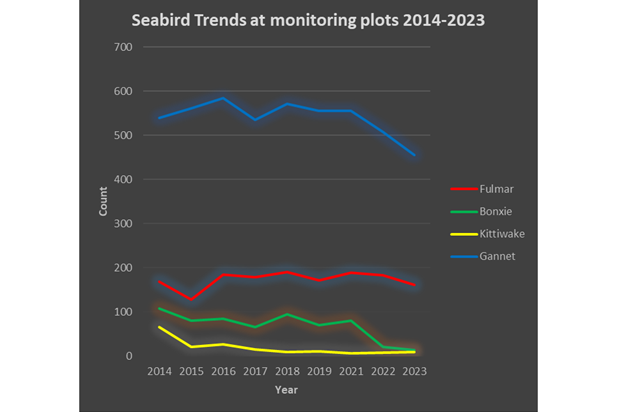
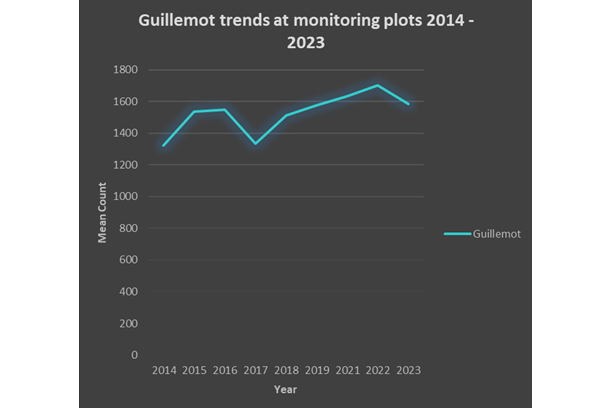
Counts for Guillemot as outlined in the objective description are displayed as a line graph showing a slight increase in numbers.
In the face of these declines we have worked to minimise some of the additional pressures on the nesting seabirds. The data collected on the reserve is submitted annually to the UK Seabird Monitoring Programme and contributes to making informed assessments on the impacts of marine renewable developments and provides ongoing surveillance of changing seabird trends in the face of climate change.
The reserve staff engage with every person who visits the reserve, either by our ferry or by private boat/kayak, to provide instructions on how to reduce human disturbance to nesting seabirds and highlight sensitive areas that should be avoided. One of the greatest threats to nesting seabirds is non-native invasive predators and although there are currently no invasive predators on Noss, rats are present on the neighbouring island of Bressay which is only 130m away. The reserve benefited from the Biosecurity for LIFE project in 2021 and as a result a biosecurity plan for Noss was implemented, with 19 bait stations installed across the island which are checked monthly during the breeding season. The risk of an incursion was further highlighted when a great skua was found to bring a dead rat to the reserve in 2023. Going forward, biosecurity surveillance will continue to be a priority on the reserve.
Field research for five different projects was carried out on the reserve, which included a study into nest incorporation of debris in gannet nests that was part of a wider study across their range, and a PhD project looking at the impact of changes in fishing practices on enrichment of vegetation due to fertilisation from great skua faeces. There is also an ongoing study into great skua diet through annual pellet collection which has been used to inform on the diet choices of these birds in response to EU fisheries policy changes and impacts of marine fishing practices.
Grazing has been maintained at 1 ewe per hectare with the aim of providing the appropriate ground nesting conditions required for great skua. The sheep have a noticeable impact on the abundance of flowering plants on the reserve with this most visible at Papil Geo where the sheep have long been excluded, and on the inaccessible cliffs of the geos. A management plan for an agri-environment scheme application was produced for the Garth Estate by Nathalie Pion which involved seasonal sheep exclusion from areas of Hill of Papilgeo to benefit coastal heath. The application has so far not been taken forward, but should be encouraged to benefit wider biodiversity on the reserve and demonstrate exemplary management.
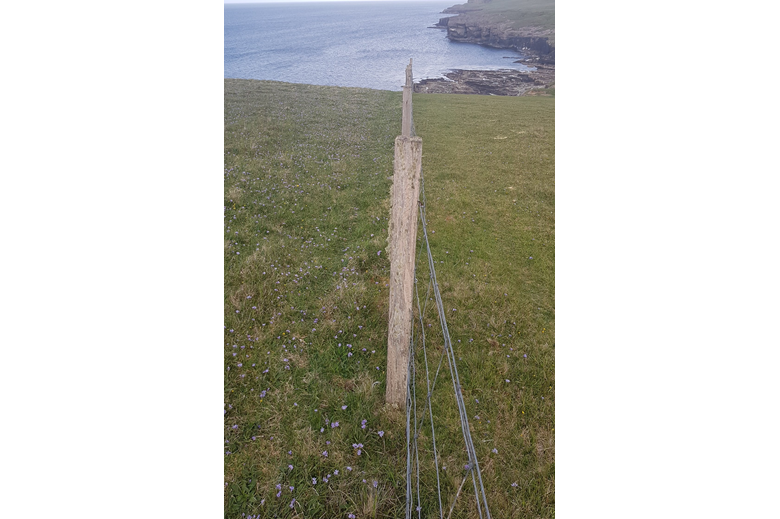
Management for People
Objective VM1: Provide a high quality visitor experience. Exceed target of 1500 visitors per year ensuring that >85% of visitors asked rate their experience as good or above.
Projects to be delivered during life of plan
| Task No. | Task description | Task outcome |
|---|---|---|
|
VM1.1 |
Provide Noss Ferry between end April and end August and maintain Ferry Information line - adding additional information to Lerwick-Bressay Ferry terminal and local outlets (e.g. heritage centre, tourist facilities). |
Achieved & on-going |
|
VM1.2 |
Seasonal staff to provide a welcome brief to all visitors. Include natural heritage background, the work of NatureScot and health and safety information. |
Achieved & on-going |
|
VM1.3 |
Promote Noss NNR through Tourist Information Centre, local press, radio and accommodation providers.
|
Achieved |
|
VM1.4 |
Organise and run an annual Noss NNR Open Day.
|
Achieved (when practicable) |
|
VM1.5 |
Complete a Visitor Centre Exhibit plan in 2018 focusing on the island's seabirds and raising awareness of impacts of climate change globally on seabird populations. |
Achieved in 2020-23 |
|
VM1.6 |
Implement Visitor Centre Exhibit Plan by 2019. |
Achieved in 2023 |
|
VM1.7 |
Review and update information about the Reserve on the Scotland's NNRs website every 6 months. Provide links to downloadable material on the seabirds and the impacts of climate change as this becomes available. |
Achieved |
|
VM1.8 |
Seasonal staff to use social media to provide regular up to date information about Noss NNR to a wider audience. |
Achieved |
|
VM1.9 |
Distribute reserve leaflet to local outlets. Review and update NNR leaflet in 2017. |
Achieved |
|
VM1.10 |
Collate visitor numbers and update quarterly reporting during visitor season. |
Achieved |
|
VM1.11 |
Carry out Visitor survey to provide qualitative information on visitor experiences. |
Not achieved |
|
VM1.12 |
Organise and run a bird monitoring training day every third year. |
Not achieved |
|
VM1.13 |
Provide a programme of guided walks during the open season - at least 2 per month May to August with additional guided walks on request. |
Part achieved – once a month |
Objective evaluation:
The Noss ferry continued to operate from end of April to end of August until 2018 when the operational period changed to the start of May to end of August. The ferry information line was updated daily to inform visitors of any changes to ferry operations when weather or other factors such as covid-19 restrictions and an HPAI outbreak caused the ferry to be cancelled. All visitors were given an introductory talk by reserve staff in the visitor centre upon arrival, which included information on the seabird monitoring carried out on the reserve, the best places to spot certain wildlife, sensitive areas to avoid and health and safety information. Being ferried across Noss Sound in a Zodiac and having face-to-face interaction with the warden is a unique experience which greatly enhances the visit to Noss, and for many is the highlight of a visit to Shetland.
Visitor numbers between 2016 and 2019 increased from an average of 1,500 to an average of 2,180 visitors per year which is the highest they have been since before 1991, when visitor figures were as many as 3,000. The reserve was closed to visitors in 2020 due to the covid-19 pandemic and a limited ferry service ran the following year in 2021. The reserve was again closed from July onwards in 2022 due to an outbreak of HPAI. 2023 was a return to normal operations and visitor numbers returned to what was expected in the years before covid-19.
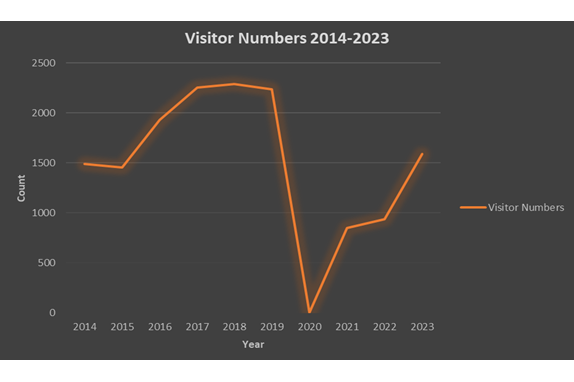
Visitor numbers to Noss NNR are displayed as a line graph. Starting at around 1500 visitors in 2014 numbers increased to around 2,250 plummeting in 2020 when due to Covid 19 there were no visitors. Subsequently numbers have begun to increase post Covid but were still not as high in 2023 as in 2018.
There were six Noss Open Days over the course of the reserve plan however weather, HPAI and covid-19 gave reason to cancel four open days. It continues to be a popular and well attended event when it does go ahead and is the best way to attract locals to the reserve, including those outwith the usual visitor profile such as young families and those from lower income groups.
Two Facebook pages were created for the reserve. ‘Birds of Noss’ is a Facebook group that both the reserve staff and the general public can post to and has grown from 350 followers in 2016 to nearly 1,000 in 2023. The other page is a NatureScot NNR acount that only NatureScot staff has posting permissions for and also has 1,000 followers.
A guided walk was made available to book on the last Saturday of every month however it has had a low uptake in recent years with most visitors choosing to explore Noss on their own. 11 guided walks were booked over the course of the plan plus seven on Open Days. Several groups lead by tour leaders, specifically photography tours, made repeat journeys and Noss is a popular draw for clients on their itinerary.
The reserve leaflet was updated and reviewed in 2022 and a mini Noss annual report was provided annually for visitors. Both were also made available digitally on the NNR website.
The interpretation in the visitor centre was redesigned with initial plans drawn up in 2020 and a contract awarded to MacDonald Orr in 2023 for design and production. The room was brightened up with a new coat of white paint which replaced the duck egg blue colour on the walls. Visitors obtain most of their information from reserve staff during an introductory welcome talk and so the interpretation was designed with fewer words and more visual information that could be used as a visual aid to supplement the information provided by reserve staff. Information on the new panels included infographics on threats to seabirds and plastic pollution, a lifesize cut-out of a gannet, a seabird migration map, history timeline, commissioned illustrations of seabirds at the Noup and marine life showing diving depths and food foraging behaviour, photographs of gannets diving off the Noup provided by a local photographer and a whiteboard to provide up to date information on the breeding seabirds and recent sightings. The display of skulls, crab shells and other marine life continues to be popular with both adults and children alike, and the commissioned illustrations now put these collections into context for visitors. The new interpretation has already been well received by visitors however full installation will be completed in 2024 once a damp issue in the gable end wall has been addressed.
A visitor survey was not conducted during the course of the plan however a comments book in the visitor centre gives a flavour for the experience visitors have encountered on their trip. Other than the expected comments on the weather and lack of puffins, all feedback was positive with many claiming it to be either the highlight of their holiday or the best place they have ever visited.
Objective VM2: Engaging with the community: To engage with local community on Bressay and support volunteering.
Projects to be delivered during life of plan
| Task No. | Task description | Task outcome |
|---|---|---|
|
VM2.1 |
Contact local schools and support at least 1 school visit each per year. |
Partially achieved |
|
VM2.2 |
Engage at least 1 local volunteer annually for regular tasks on the Reserve. |
Not achieved |
|
VM2.3 |
Develop list of volunteer tasks and provide volunteer opportunities for at least 1 work party every alternate year. |
 Not achieved |
|
VM2.4 |
Engage with and utilise local contractors. |
Achieved |
Objective evaluation:
The primary school in Bressay closed in 2014 and although this has led to a disconnect with the younger island residents efforts were made in 2021 to engage with local children on Bressay through joint guided culture and natural history walks with Bressay Development. These were well received and resulted in some of the children making future trips to the reserve with their parents, some of who had never before visited the reserve. Noss is a fantastic resource for engaging children with the natural word and we would like to build better and stronger relations with local schools, youth groups and the children living in Bressay.
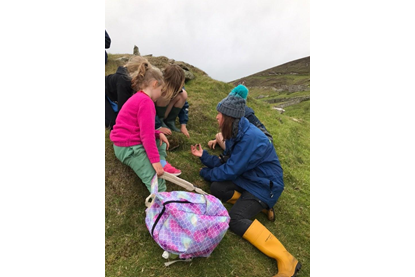
Shetland schools’ Outdoor Education service brought school groups to Noss in the past, but this has not happened for a few years now. We have contacted them to explore whether this can be resumed, as it is a great way to introduce local young people to Noss and nature in general, as well as an exciting day out (with a trip in an inflatable boat!).
We offered a day’s work experience on the reserve to a student from the local high school in Lerwick as part of a week’s work experience with NatureScot in Shetland. This occurred once a year until 2019 when the programme was suspended from 2020 onwards due to covid-19. Should it recommence we will continue to facilitate any work experience students on the reserve.
We haven’t actively sought to attract volunteers as volunteering opportunities on the reserve are limited however when enquiries have been made with regards to volunteering on Noss we have strived to accommodate these requests. A steering group was set up to establish a Junior Ranger programme in Shetland and we produced a list of activities that we could offer to host junior rangers on the reserve as part of the programme. The programme has not yet come to fruition however the list of tasks created would be useful in helping to build upon links with other local youth groups.
The annual Noss Open Day has been the primary way of offering both volunteer opportunities and community engagement, typically involving around 30 local volunteers.
When available local contractors were used for work on the reserve. Annual service and maintenance of boats, engines, equipment and gas supply were carried out locally by Thulecraft, Shetland Power Tools, Malakoff and REARO. Work was contracted to Bressay residents Helen Christie for illustrations used in the visitor centre interpretation and Chris Dyer for repair to the garden dyke. Local photographers were used for photos used in the new visitor centre interpretation.
Management for Property
Objective PM1: To manage the reserve property responsibly following best practice.
Projects to be delivered during life of plan
| Task No. | Task description | Task outcome |
|---|---|---|
|
PM1.1 |
Carry out quarterly safety and condition assessments of all visitor infrastructure and keep accurate records during visitor season. |
Achieved |
|
PM1.2 |
Ensure the management of the property complies with Health & Safety Regulations including risk assessment and annual fire plan reviews. |
Achieved |
|
PM1.3 |
Maintain leased building in accordance with listed building planning. |
Achieved
|
|
PM1.4 |
Prevent erosion around the scheduled ancient monument and access close to Gungstie in conjunction with estate. Main technique is laying netting to reduce rabbit damage. |
Achieved |
|
PM1.5 |
Maintain reserve equipment and infrastructure. |
Achieved |
|
PM1.6 |
Carry out annual beach clearance at end April ahead of main visitor period. |
Achieved |
|
PM1.7 |
Improve Noss Shore landing point - install guide posts by 2016 that can be used as support when rocks are slippery. Even out path by further use of concreted stone steps. |
Achieved |
|
PM1.8 |
Ensure retention of Green Tourism Board Scheme award. |
Achieved |
|
PM1.9 |
Renew Gungstie Building lease. |
Achieved |
|
PM1.10 |
Maintain terms of the Nature Reserve Agreement. |
Achieved |
Objective evaluation:
Visitor facility inspections were carried out quarterly and actions from the survey were completed as soon as possible. Non-compliant stiles on the reserve were removed and replaced with those that were complaint in 2019. Wooden pallets and planks of wood with grip strips which had been installed to help traverse wet crossings were removed in 2019 and replaced with natural footpaths using large, flat stones sourced from the surrounding area.
Property on the reserve has been well maintained and efforts continue to be made to improve the condition of the accommodation and office space under the constraints of the reserve’s remote location. The electrical system was improved in 2017 with the installation of a new wind turbine and a charge controller system for the solar and wind power which now generates enough power to negate the need of the generator. The fire alarm system was updated with battery powered interlinked smoke and heat alarms in 2022 to comply with new fire safety regulations. The wood burning stove was also replaced and will comply with fire regulations when work around the fire place is completed next year. Asbestos was removed from the property in 2021. Filpumps took over the contract for servicing the water system and alterations made by them over the past five years has improved the system and the water has been declared safe to drink by Environmental Health most years since 2019.
A section of the landing point on Noss was concreted in 2016 to level out the ground at the embarkation point. Guided posts were also installed to aid visitors over uneven ground. We will continue to review and consider ways to improve the ease of access at the landing point on the Noss side of the crossing.
Erosion of the banks at Nesti Voe and Flitsand has worsened and continues to be a growing issue. The underground water pipe that supplies Gungstie with water from the well at Turness became exposed where the West bank of Nesti has further retreated and as a result a new pipe had to be re-routed further inland in 2022. Rabbits and sheep are exacerbating the situation and in some areas are the main cause of the erosion. Rabbits have been culled around the inbye area over the winter months however it has had an insignificant impact on the population. A study to explore the feasibility of eradicating rabbits on Noss was commissioned in 2019/20 but this concluded that it would be extremely challenging and costly. Efforts were made to stem the erosion, first in 2015 by laying chicken wire on the bank below the buildings at Flitsand and then in 2021 and 2022 by creating a sand trap from brash on the exposed East bank of Nesti. We plan to transplant marram grass behind the sand trap to stabilise the bank here and would like to investigate similar methods at other areas where erosion is posing a risk to losing walls and buildings.
An annual beach clean of the reserve’s inbye beaches has been carried out as part of the Shetland-wide Da Voar Redd Up every year. Several bags of litter and marine pollution has been removed from the reserve thanks to the efforts of the wider NatureScot team in Shetland and volunteers.
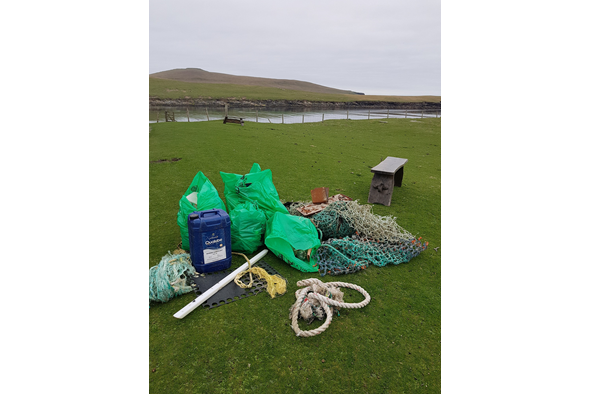
Summary
Overall, we are content that we are managing the reserve for the best conditions that we can for the seabird populations where it is within our control. There is little management on the reserve itself that we can do for species that are suffering declines that are consistent with UK wide declines and which are connected to climate change and food availability. Fulmar, shag, great black-backed gull, herring gull, black guillemot, guillemot, razorbill and arctic tern have remained stable over the course of the plan. Gannet and great skua numbers were either stable or increasing before the outbreak of HPAI. Puffin and kittiwake numbers have continued to decline and Arctic skua may be gone as a breeding bird on the reserve. The monitoring of seabird populations continues to be a priority on Noss and the data is contributing to UK surveillance of the health and changing trends of seabirds. The importance and worth of the data collection was further highlighted at the outbreak of HPAI. We would like to explore whether we could improve management for wider biodiversity and climate change mitigation, whilst maintaining suitable habitat for great skuas.
The covid-19 pandemic and the HPAI endemic were unforeseen circumstances which have had an impact on the outcome of some of the objectives outlined in the plan, namely the levels of visitors that the reserve has received. However, visitor numbers were initially increasing before the pandemic and as things have returned to normal so has the general public’s interest in visiting Noss. Positive feedback in the comments book indicate that visitors are having a good visitor experience and we hope the new improvements to the visitor centre will further enhance that in the upcoming seasons. School visits have taken a dip with the closure of the Bressay primary school, but we will explore ways to promote visits by schools and youth groups once more.
The way ahead
Our next steps are to draft a new ten year management plan for the reserve taking account of what we have learnt from our past management and what we still need to continue with to ensure we fulfil our 2038 vision for Noss NNR.
Document properties
Author: Jen Clark
Editor: Juan Brown and Neil Mitchell
Approved by: Juan Brown
Date: 08/12/23




